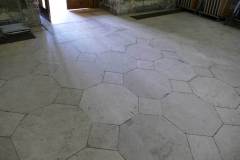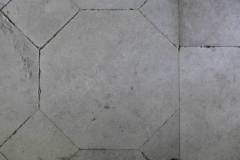Basics
Geology: shelly limestone
Rock unit: Bee Low Limestone Formation
Age: Carboniferous
Provenance: Middleton, Derbyshire
Where to see examples in flooring
Where to see examples in memorials
Chapter House (see images further below)
Memorial plaque to Edward Youde
Part of the memorial to Archbishop Davidson
Stone tablet to Ms Babington in nave (south side)
Description
This stone was quarried from the south east of the Derbyshire Peak District (Middleton, near Wirksworth). It is also known as Hoptonwood Stone. The stone beds were formed about 330 million years ago in warm, clear tropical seas during the Carboniferous. The variety used for the flooring is known as Light Hopton Wood (as opposed to the dark variety) and is a fine cream-coloured shelly limestone cemented by fine crystalline calcite. The fossil material that can be seen on newly laid slabs is mainly the broken shells of bivalves with occasional crinoidal debris (from sea lilies). The floor in the Chapter House is now over 100 years old and the original features of the stone are not always easy to see.
Hopton Wood Stone was often marketed as a “marble” on account of its ability to take and retain a good polish. In the early twentieth century the distributor was even incorrectly marketing the stone as a true geological marble. As a flooring material the stone has been used extensively at Chatsworth House and in the Houses of Parliament and during the 1880s was supplied for the floors of the Royal Courts of Justice in the Strand.
Click on the images below to expand and read the captions.
The last major refurbishment of the Chapter House took place in 1898. The former floor – a mix of memorial slabs brought in from the nave clearance in 1787, red tiles and a few slabs covering actual graves, were replaced by octagonal slabs of Hopton Wood Stone.


